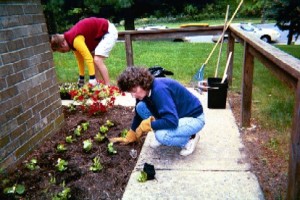Latest Posts
- Have a purpose when backyardingAugust 5 2021
- Study: Time outside alters our microbiomeAugust 4 2021
- Happy National Mutt Day from Mo-MoJuly 27 2021
- New home? Avoid these common mistakes in your yard.July 26 2021
- Infographic: Plan a backyard staycation this summerJuly 22 2021
Categories
Archive
April 8th
Tips for spring planting the pet-friendly way

Spring is in the air, and that means many people are getting the itch to plant. You already know to check the climate map so you can choose the right plants and grasses for where you live.
But what is the best way to start thinking about spring planting if you have dogs? Here are a few things to keep in mind.
- Think about what your dog needs.
Dogs love living landscapes and love being in your yard. What does your dog need the most in a yard? A place to romp and exercise? A place to relax in the shade for an afternoon nap? - Pick “dog-proof” ground coverings.
Grass is one of the best ground coverings around because it can handle the wear and tear that comes with pets and children. Bermuda and buffalo grass are especially hardy, and they are drought-resistant, too. Grass also delivers great health benefits for you and your family by producing oxygen, sequestering carbon, capturing water runoff, and cleaning and filtering rain water. - Select appropriate plants.
For areas near your garden paths, select plants that have soft foliage, but are still sturdy enough to withstand a little canine “ruff”-housing. You can check the ASPCA’s list of toxic and non-toxic garden plants for advice. - Avoid plastic grass.
Plastic grass, also known as artificial turf, gets too hot for humans and pets, especially in summer months. A 2002 Brigham Young University study revealed that synthetic-turf surface temperatures were 37 degrees higher than asphalt and 86 degrees hotter than natural turf.[i] A 2012 Penn State study found it wasn’t uncommon for temperatures to surpass 150 degrees and can reach up to 200 degrees.[ii] - Recycle grass clippings.
Lawns sequester the largest amount of carbon when they recycle the nitrogen contained in grass clippings. So, take off your lawn mower’s mulching bag and leave your grass clippings on the ground while mowing. The clippings will break down and feed your grass naturally. You can also apply some compost to your lawn in the spring with your seed spreader to help feed it.
To learn more about how living landscapes benefit people and pets, click here.
________________________





